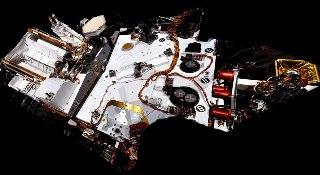
The left eye of the two-camera Mast Camera (Mastcam) instrument on NASA's Mars rover Curiosity took the images combined into this mosaic of the rover's upper deck. Photo by NASA/JPL-Caltech/Malin Space Science Systems
PASADENA CALIFORNIA (BNS): Two digital colour cameras riding high on the mast of NASA's next Mars rover will complement each other in showing the surface of Mars in exquisite detail, NASA said.
They are the left and right eyes of the Mast Camera, or Mastcam, instrument on the Curiosity rover of NASA's Mars Science Laboratory mission, launching in late 2011.
The right-eye Mastcam looks through a telephoto lens, revealing details near or far with about three-fold better resolution than any previous landscape-viewing camera on the surface of Mars.
The left-eye Mastcam provides broader context through a medium-angle lens. Each can acquire thousands of full-colour images and store them in an eight-gigabyte flash memory.
Both cameras are also capable of recording high-definition video at about eight frames per second. Combining information from the two eyes can yield 3-D views of the telephoto part of the scene.
Researchers will use the Mastcams and nine other science instruments on Curiosity to study past and present environments in a carefully chosen area of Mars. They will assess whether conditions have been favourable for life and favourable for preserving evidence about whether life has existed there.
When Curiosity drives to a new location, Mastcam 34 can record a full-colour, full-circle panorama about 60 degrees tall by taking 150 images in about 25 minutes.
Using Mastcam 100, the team will be able to broaden the swath of terrain evaluated on either side of the path Curiosity drives, compared to what has been possible with earlier Mars rovers.
 Previous Article
Previous Article Next Article
Next Article











The Indian Air Force, in its flight trials evaluation report submitted before the Defence Ministry l..
view articleAn insight into the Medium Multi-Role Combat Aircraft competition...
view articleSky enthusiasts can now spot the International Space Station (ISS) commanded by Indian-American astr..
view article